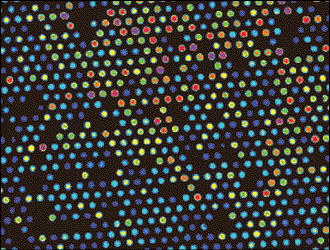
Microspheres Identify Odors
Kevin Robinson
For anyone who has trouble telling when the milk has gone bad, help may be on the way, thanks to an artificial nose that is under development at Tufts University and the University of Leicester in Leicester, UK. Currently, the system can detect smells as complicated as hazelnut-flavored coffee.

A team at Tufts University and the University of Leicester has developed an artificial nose using optical fiber and fluorescent microspheres. The patterns of fluorescence correspond to particular odors and are recognizable by a computer. Courtesy of Keith J. Albert.
The backbone of the technique is a relatively simple optical sensor array. The researchers use porous microspheres -- the packing material from high-performance liquid chromatography columns -- as the sensor substrate. After rinsing the microspheres with ethanol or acetone and exposing them to surface-modifying chemicals, the researchers soak them in a 0.5-mg/ml solution of Nile Red fluorescent dye. Altering the surfaces of the microspheres shifts their excitation and emission spectra.
The group, which includes David R. Walt and Keith J. Albert of Tufts and Tim C. Pearce and Daljeet S. Gill of Leicester, then creates an array by depositing the microspheres into etched wells on the faces of optical imaging fibers. Each fiber contains one type of fluorescent microsphere, and the array is imaged through an inverted Olympus fluorescence microscope with a xenon light source and a 640 x 480-pixel Sensicam CCD from The Cooke Corp. of Auburn Hills, Mich. A vapor delivery system passes the sample to the array.
"When the array of sensors is exposed to a particular vapor, the vapor affects each microsphere differently," explained Walt. "The amount of vapor and the vapor's polarity are reported by the Nile Red via a spectral change or an intensity change." Thus, he said, exposing the array to a sample yields a characteristic pattern of spectral changes, which the researchers train a computer to recognize as a particular odor.
'The nose knows'
There are numerous applications for a robust artificial nose, ranging from a land-mine sensor to a refrigerator that can tell you when your food has spoiled. Currently, the researchers set up the system for the vapors they are trying to identify, but the ideal system would have an array that responds to a range of odors. Walt said that it is feasible to create an array comprising more than 10,000 sensors.
The researchers are working to apply the artificial nose to the diagnosis of illness by breath analysis, and they hope to analyze liquid samples with similar methods. Walt said that they also hope to develop a database of odors that they could use with different sensors without having to retrain the computer analysis system.
A report of the researchers' work appeared in the June 1 issue of Analytical Chemistry.
Published: September 2001